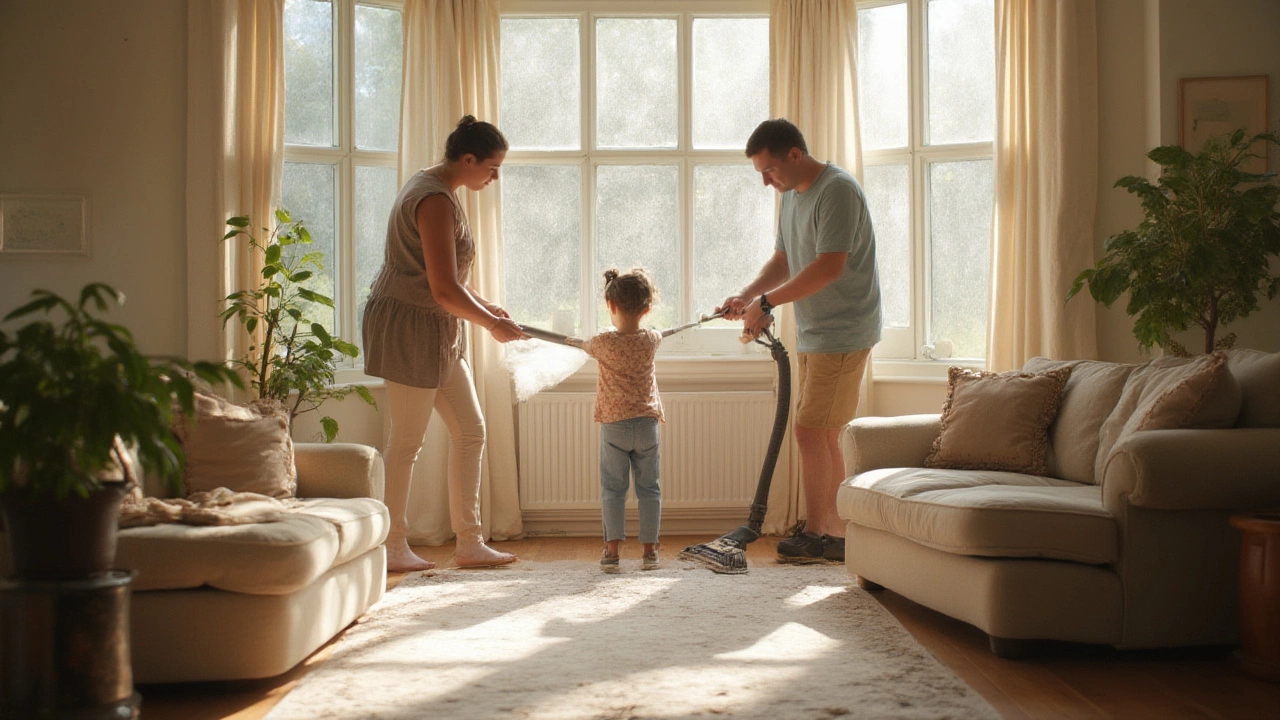Ever noticed how, no matter how often you wipe, dust just keeps coming back? City apartment, country house, doesn’t matter—dust settles everywhere. It piles up behind sofas, collects on fans, and forms mystery fluff bunnies under beds before you can blink. And if you’re anything like me, you’ve probably wondered if it’s possible to win this invisible war, or if we’re all just doomed to a never-ending game of catch-up. But here’s the kicker: the average six-room home collects 40 pounds of dust every year. That's not a typo—forty pounds. There are reasons your house feels dustier than your neighbor’s, and you can do something about it.
Where Does All This Dust Come From?
Not all dust is created equal. The stuff blanketing your bookshelf comes from a dozen sources. Some of it hitches a ride on your clothes and shoes, some of it drifts in from outside, and a decent chunk is created right in your home. According to research from the American Chemical Society, about 60% of household dust comes from outside—mostly soil, pollen, and other things you might track in on your shoes or through open windows. The rest? Dead skin, pet dander, fibers from carpets and furniture, and even tiny particles from things you cook or burn, like candles. Every time you fluff a pillow, change your clothes, or open a door, you’re releasing more into the air.
Your environment plays a big role too. Live in a city near a busy street? You’re likely dealing with extra soot and particulate matter compared to folks in rural areas. Got pets? Those lovable furballs shed dander, hair, and even microscopic skin flakes. Even the air itself contributes, especially in dry weather when static makes dust cling to everything. And if your HVAC system isn’t up to snuff, it can literally blow dust all over the place. That’s not even counting what you can’t see—microscopic mites, spores, and other bits that happily float under the radar.
Want some eye-opening data? Check out this table below. It’ll give you a sense of what dust is made of and where it comes from.
| Dust Component | Approx. Percentage in Homes | Main Source |
|---|---|---|
| Outdoor Particles | 58-62% | Soil, pollen, pollution |
| Skin Cells | 16-20% | Humans & pets |
| Textile Fibers | 7-10% | Clothing, carpets, furniture |
| Cooking Particles | 5-7% | Food preparation, smoke |
| Other (mold, mites, etc.) | 5-10% | Variable |
So, when you’re dusting, you’re not just wiping away dirt—you’re managing a whole city’s worth of microscopic “imports” and homegrown bits. Some of this you can’t completely prevent. But you can play defense and cut down on what actually makes it into your living space.
Everyday Habits That Actually Help Reduce Dust
Staying on top of the dust game isn’t about total elimination—that’s nearly impossible. It’s about slowing the buildup and being strategic. One surprisingly effective habit? Taking your shoes off at the door. A 2019 study out of the University of Arizona showed shoes track in nearly half the lead dust found in a typical American home. Try this with your family and watch how quickly floors stay cleaner.
Next, pick the right cleaning tools. Forget feather dusters—those old-school things just flap dirt into the air. Go for microfiber cloths or electrostatic dusters. They pick up and trap particles instead of spreading them. Vacuuming is essential, but not just any vacuum will do the trick. If you’ve got carpets, use a vacuum with a HEPA filter. Standard vacuums can shoot fine particles right out the back, basically redistributing the dust you’re trying to get rid of.
Here’s the part a lot of folks skip: washing bedding and curtains regularly. We’re talking every one to two weeks. These fabrics are dust magnets, especially if you have pets that like to lounge on your bed or stare out the window all day. Same story with those throw blankets that never seem to move from your couch.
Don’t forget the invisible places. Ceiling fans, the tops of door frames, the blades of AC units. These spots silently collect a thick blanket of grime until the day you finally look up and recoil in horror. Set a calendar reminder to dust high spots at least once a month.
Want a quick bullet list of solid dust-fighting habits? Here you go:
- Remove shoes at the door (seriously, it works)
- Use a damp microfiber cloth for dusting
- Vacuum high-traffic areas with a HEPA filter twice a week
- Wash bedding every week, and curtains/blankets monthly
- Brush and bathe pets regularly (outside if possible)
- Don’t forget baseboards, window sills, and behind appliances
Stick to these and you’ll see less dust sticking around. You’ll never get rid of every speck, but a consistent routine can cut it way down and help your house feel cleaner for longer.

Big Changes That Make a Real Difference
Some dust problems go way beyond a lazy Thursday’s worth of cleaning. Sometimes, you need to make real changes to how your home is set up or maintained. Think of it like a dust-proofing project. For instance, ditching heavy wall-to-wall carpets for hard flooring can make a big difference. Rugged surfaces trap far less dust than plush fibers. Swapping to wood, laminate, or tile—with a few area rugs you can shake out or wash—can transform a house, especially if you’ve got allergies. That’s something my wife, Ella, swears by. After our old carpet came out, our “dust bunnies” started disappearing within a month.
Here’s another big one: air quality. Most people know about changing HVAC filters, but they wait until the seasons change or something smells weird. Truth is, those filters work best if swapped out every 2-3 months, and some homes—especially with pets or in dusty regions—need new filters even faster. Go for filters rated MERV 8 or above. Don’t trust your system alone? Plug in an air purifier with a HEPA filter. An EPA report from 2023 claims HEPA air purifiers can remove up to 99.97% of airborne particles as small as 0.3 microns, which covers nearly everything in typical household dust. Set the purifier near pet zones, or wherever shoes come off, and you’ll feel the difference.
Let’s talk windows for a second. Open windows are great for a breeze, but if you live near a road or have pollen issues, every puff of wind brings in a new cloud of dust. Keeping windows closed on heavy traffic or high pollen days helps a lot. On the other hand, running exhaust fans in kitchens and bathrooms doesn’t just fight moisture and odors—it also pulls dust and airborne stuff out as they circulate.
Want a DIY project? Sealing cracks or gaps around windows and doors makes a real difference. Dust finds its way through even the tiniest opening. Affordable weatherstripping from the hardware store can give you a leg up. And get this: the National Air Duct Cleaners Association says cleaning HVAC ducts every few years in older homes can make a difference if you notice extra dust or respiratory issues, especially after you’ve moved into a new place or finished renovations.
Check out this quick table comparing common household features and how they impact dust collection:
| Feature | Impact on Dust |
|---|---|
| Wall-to-wall carpet | High |
| Hard floors (wood/tile/laminate) | Low |
| Cloth curtains | Moderate |
| Blinds (plastic/metal) | Low |
| No pets | Lower |
| Pets (especially long-haired) | Higher |
| Open windows often | Higher |
| Well-sealed doors/windows | Lower |
If you’re building, renovating, or just ready for a change, small upgrades like swapping textiles for easy-clean surfaces or investing in smart tech like robotic mops can save a lot of effort in the long run.
What About Allergy and Asthma Sufferers?
If you or someone at home has allergies, dust isn’t just a cleaning nuisance—it can mean miserable sneezing, coughing, even skin irritation. Studies from the Asthma and Allergy Foundation of America make it clear: home allergens are one of the top reasons for year-round allergy symptoms. The biggest culprits hiding in dust? Dust mites, pet dander, and mold spores. Unlike pollen, which comes and goes with the seasons, these little buggers stick around all year.
One easy win? Using pillow and mattress covers that are specifically labeled allergen-proof. These block out dust mites, which love living in mattresses and pillows. Washing bedding in hot water (above 130°F) every week kills mites and washes away their waste—major trigger for many. For curtains or upholstery you can’t wash, try vacuuming with a special upholstery tool or using a steam cleaner.
If you live with pets and allergies, regular grooming is non-negotiable. Brushing them outside keeps a world of fur, dander, and dirt from settling in your home. And if you’ve got kids (or clumsy adults) who spill snacks or crumbs, stay vigilant—crumbs provide snacks for pests that add to your dust burden.
A lot of folks forget about air humidity, but it matters. Dust mites and mold love damp spaces, so keeping your home’s relative humidity under 50% does double duty. Run dehumidifiers if you live somewhere humid. On the flip side, dry air makes dust lighter and more likely to float (and tickle your nose). Keeping things around 40% humidity is a solid compromise.
Here’s a quick action plan for the allergy-prone:
- Use allergen-proof bedding and pillow covers
- Wash all linens in hot water weekly
- Vacuum and steam-clean upholstery regularly
- Keep humidity at 40-50%
- Brush pets and wash their bedding often
- Invest in a HEPA-filter air purifier for bedrooms and main living spaces
No one expects a perfectly clean house, but with a few targeted habits—shoes off, cleaner air, sealed windows, less fabric—dust doesn’t have to run the show.

